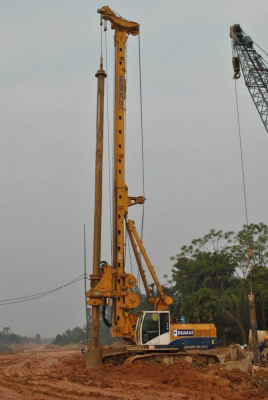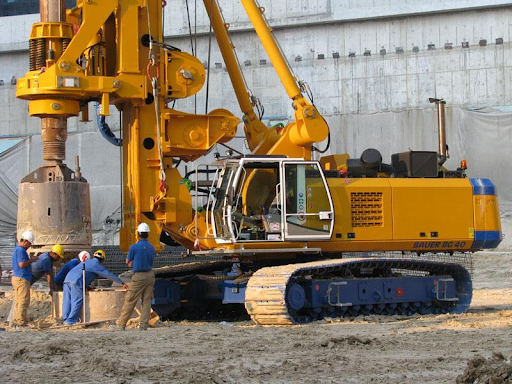Augered pile is a type of reinforced concrete pile cast in situ within drilled holes in the ground. The creation of these boreholes can be carried out through various methods such as manual digging, or more modern approaches involving drilling machines or equipment to form the holes.
The construction method of augered pile foundations is highly regarded for its numerous advantages, both in terms of structural integrity and execution. However, this approach also has some drawbacks, such as the need for thorough site investigations and a construction process highly dependent on weather conditions.
In essence, the structure of an augered pile will include the following components:
Vertical Reinforcement Bars:
The diameter and quantity of vertical reinforcement bars depend on design requirements and calculations for placement. The minimum diameter is typically d12, with the reinforcement bars for compressive loads oscillating between 0.2% to 0.4%. For piles subjected to bending, tension, and uplift, the steel content ranges from 0.4% to 0.65%. The minimum distance between vertical bars is 10cm. To ensure safety, engineers often distribute 100% of the steel at the pile head and gradually reduce the amount towards the pile base. For piles under compressive loads, steel reinforcement may be concentrated within the top third of the pile length if it is centered; however, for safety reasons, engineers usually distribute steel evenly along the entire length.

Ring Reinforcement Bars:
The diameter and spacing of ring reinforcement bars vary depending on design requirements. The diameter typically fluctuates between d6-d12, with a minimum spacing of 200-300mm. Single or continuous helical bars can be used, but continuous helical rings are usually more suitable for piles with a diameter smaller than 80cm.
Reinforcement Steel Bands:
Reinforcement steel bands are often placed within the cage to enhance stability. The diameter of these bands ranges from d8-d20, with one band arranged every 2 meters.
Steel Collar to Protect Reinforcement Bars:
A steel collar serves to create a protective layer of concrete around the reinforcement bars. For augered piles, this protective concrete layer has a thickness of 5-7cm and consists of circular cement collars with holes in the middle, threaded onto the reinforcement bars during the installation of steel bands.

Borehole Pipes:
The number of borehole pipes required for the project depends on the cross-sectional area of the augered pile. If the pile diameter is less than 1m, approximately 3 borehole pipes may be needed, while a diameter between 1-1.3m might require 4 pipes, and a diameter greater than 1.3m may require 5 or more pipes. The pipes can be made of plastic or steel, with steel pipes being necessary for piles with a diameter larger than 1.5m or a length exceeding 25m. The pipes are welded directly to the steel ring or attached using welded steel clamps.
Testing Tubes:
Testing tubes are essential for the construction, and the required number depends on the pile diameter. If the pile diameter is <1m, typically 3 testing tubes are needed; for a diameter of 1-1.3m, 4 tubes are used, and for a diameter >1.3m, 5 tubes or more are required. The material for testing tubes can be plastic or steel. However, for piles with a diameter greater than 1.5m or a length exceeding 25m, steel testing tubes are necessary. These tubes are welded directly to the steel ring or attached using welded steel clamps. Proper positioning of the testing tubes on the steel cage must be adhered to according to the design to ensure the stability of the tubes. The minimum number of tubes to be placed is 50% of the total number of piles to prevent concrete, soil, or rocks from blocking them. The lower end of the testing tube needs to be sealed, and the upper end should have a cover.

Hanging Hooks:
The arrangement of hanging hooks must prevent excessive deformation during the lifting of the steel cage. Hanging hooks are typically made of specialized steel and positioned according to the pre-calculated design. For convenience during lifting, the steel cage is produced in segments, which are then assembled when lowered into the drilled hole. The main steel of the steel cage is connected using 50% butt joints and 50% tied joints.
Ban truyền thông!


 VN
VN CN
CN KR
KR JP
JP